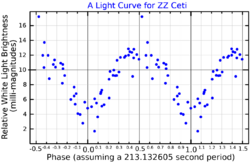Astronomy:Ross 548
| Observation data Epoch J2000.0 Equinox (celestial coordinates) | |
|---|---|
| Constellation | Cetus |
| Right ascension | 01h 36m 13.61558s[2] |
| Declination | −11° 20′ 32.6318″[2] |
| Apparent magnitude (V) | 14.16±0.01[3] |
| Characteristics | |
| Evolutionary stage | White dwarf |
| Spectral type | DA4.0[4] |
| U−B color index | −0.5[5] |
| B−V color index | 0.2[5] |
| Variable type | ZZ Cet (DAV)[5] |
| Astrometry | |
| Proper motion (μ) | RA: +460.845[2] mas/yr Dec.: −116.448[2] mas/yr |
| Parallax (π) | 30.5249 ± 0.0546[2] mas |
| Distance | 106.8 ± 0.2 ly (32.76 ± 0.06 pc) |
| Absolute magnitude (MV) | 11.78±0.06[6] |
| Details[6] | |
| Mass | 0.65±0.02 M☉ |
| Radius | 0.0118±0.0002 R☉ |
| Luminosity | 0.0029±0.0002 L☉ |
| Surface gravity (log g) | 8.108±0.025 cgs |
| Temperature | 12,281±125 K |
| Rotation | 37.84±1.99 h |
| Other designations | |
| Database references | |
| SIMBAD | data |
Ross 548 is a white dwarf in the equatorial constellation of Cetus.[7] With a mean apparent visual magnitude of 14.2[3] it is much too faint to be visible to the naked eye. Based on parallax measurements, it is located at a distance of 107 light years from the Sun.[2] It was found to be variable in 1970[8] and in 1972 it was given the variable star designation ZZ Ceti.[9] This is a pulsating white dwarf of the DAV type that is the prototype of the ZZ Ceti variable class.[10], pp. 891, 895.[3]
This DA-class white dwarf is the surviving core of a red giant star that ceased nuclear fusion while shedding its outer envelope. It has a (presumably) homogeneous core of carbon and oxygen, a relatively thin outer envelope of hydrogen, and a helium mantle. The object has 65% of the mass of the Sun, with 1.2% of the Sun's radius. It is radiating 0.3% of the luminosity of the Sun at an effective temperature of 12,281 K. Ross 548 is spinning with a period of ~38 hours.[6] The dominant pulsation mode of this object has a period of 213.1326 seconds. It has up to 11 known pulsation modes in total.[3]
References
- ↑ Stover, R. J.; Hesser, James E.; Lasker, Barry M.; Nather, R. E.; Robinson, E. L. (September 1980). "Period stability of the pulsating white dwarf R 548 (=ZZ Ceti)". The Astrophysical Journal 240: 865–870. doi:10.1086/158300. Bibcode: 1980ApJ...240..865S.
- ↑ 2.0 2.1 2.2 2.3 2.4 2.5 Brown, A. G. A. (August 2018). "Gaia Data Release 2: Summary of the contents and survey properties". Astronomy & Astrophysics 616: A1. doi:10.1051/0004-6361/201833051. Bibcode: 2018A&A...616A...1G. Gaia DR2 record for this source at VizieR.
- ↑ 3.0 3.1 3.2 3.3 Giammichele, N. et al. (December 2015). "A New Analysis of the Two Classical ZZ Ceti White Dwarfs GD 165 and Ross 548. I. Photometry and Spectroscopy". The Astrophysical Journal 815 (1): 12. doi:10.1088/0004-637X/815/1/56. 56. Bibcode: 2015ApJ...815...56G.
- ↑ Gianninas, A. et al. (December 2011). "A Spectroscopic Survey and Analysis of Bright, Hydrogen-rich White Dwarfs". The Astrophysical Journal 743 (2): 27. doi:10.1088/0004-637X/743/2/138. 138. Bibcode: 2011ApJ...743..138G.
- ↑ 5.0 5.1 5.2 McCook, George P.; Sion, Edward M. (March 1999). "A Catalog of Spectroscopically Identified White Dwarfs". Astrophysical Journal Supplement 121 (1): 1–130. doi:10.1086/313186. Bibcode: 1999ApJS..121....1M. CDS ID III/210.
- ↑ 6.0 6.1 6.2 Giammichele, N. et al. (March 2016). "A New Analysis of the Two Classical ZZ Ceti White Dwarfs GD 165 and Ross 548. II. Seismic Modeling". The Astrophysical Journal Supplement Series 223 (1): 27. doi:10.3847/0067-0049/223/1/10. 10. Bibcode: 2016ApJS..223...10G.
- ↑ 7.0 7.1 "ZZ Cet". SIMBAD. Centre de données astronomiques de Strasbourg. http://simbad.u-strasbg.fr/simbad/sim-basic?Ident=ZZ+Cet.
- ↑ Lasker, Barry M.; Hesser, James E. (February 1971). "High-Frequency Stellar Oscillations. VI. R548, a Periodically Variable White Dwarf". Astrophysical Journal 163: L89–L93. doi:10.1086/180673. Bibcode: 1971ApJ...163L..89L.
- ↑ Kukarkin, B. V. et al. (September 21, 1972). "58th Name-List of Variable Stars". Information Bulletin on Variable Stars 717: 1. Bibcode: 1972IBVS..717....1K.
- ↑ Koester, D.; Chanmugam, G. (1990). "Physics of white dwarf stars". Reports on Progress in Physics 53 (7): 837–915. doi:10.1088/0034-4885/53/7/001. Bibcode: 1990RPPh...53..837K.
Coordinates: ![]() 01h 36m 13.60s, −11° 20′ 32.2″
01h 36m 13.60s, −11° 20′ 32.2″
 |


